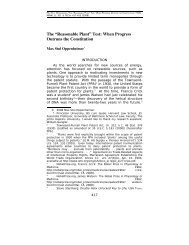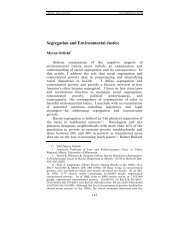An Organizational Approach to the Design of Patent Law
An Organizational Approach to the Design of Patent Law
An Organizational Approach to the Design of Patent Law
You also want an ePaper? Increase the reach of your titles
YUMPU automatically turns print PDFs into web optimized ePapers that Google loves.
6 VERTINSKY FINAL_JAD (DO NOT DELETE) 2/27/2012 2:20 PM<br />
2012] AN ORGANIZATIONAL APPROACH 235<br />
cusses <strong>the</strong> political economy <strong>of</strong> <strong>the</strong> patent system and its implications<br />
for patent reform. 104<br />
These different approaches demonstrate <strong>the</strong> potential that<br />
<strong>the</strong> analytical <strong>to</strong>ols <strong>of</strong> NIE have <strong>to</strong> shed light on new aspects <strong>of</strong><br />
patent law, but <strong>the</strong> literature lacks a foundation that can connect<br />
specific empirical studies and <strong>the</strong> insights <strong>of</strong> <strong>the</strong>oretical<br />
models <strong>to</strong> each o<strong>the</strong>r and <strong>to</strong> more comprehensive models <strong>of</strong> innovation.<br />
105 The absence <strong>of</strong> such a foundation has limited <strong>the</strong><br />
reach <strong>of</strong> NIE <strong>to</strong> influence patent policy. A key objective in developing<br />
a methodology and framework for thinking about patents<br />
and <strong>the</strong> organization <strong>of</strong> innovation is <strong>to</strong> promote <strong>the</strong> integration<br />
<strong>of</strong> existing results and <strong>the</strong> connection <strong>of</strong> <strong>the</strong>se results<br />
with both <strong>the</strong> real life systems within which different kinds <strong>of</strong><br />
innovation take place and <strong>the</strong> legislative, administrative, and<br />
judicial systems that determine <strong>the</strong> directions <strong>of</strong> patent law.<br />
Applying <strong>the</strong> insights from this literature <strong>to</strong> inform patent policy,<br />
<strong>the</strong> central inquiry for patent policymakers becomes one <strong>of</strong><br />
determining what roles patents play in structuring, facilitating,<br />
or impeding desired processes <strong>of</strong> innovation. 106<br />
100, at 1; Barnett, supra note 9, at 3; Baldwin & Hippel, supra note 100 Burk,<br />
supra note 9, at 3; Duffy, supra note 100; Gallini & Winter, supra note 41, at<br />
238; Heald, supra note 9, Kieff, supra note 9, at 328–30; Lemley, supra note<br />
100, Long, supra note 100; Merges, Intellectual Property Rights and <strong>the</strong> New<br />
Institutional Economics, supra note 9; Merges, Expanding Boundaries <strong>of</strong> <strong>the</strong><br />
<strong>Law</strong>: Intellectual Property and <strong>the</strong> Cost <strong>of</strong> Commercial Exchange, supra note<br />
41, at 1590–91.<br />
104. See, e.g., Kesan & Gallo, supra note 7 (advocating for an analysis <strong>of</strong><br />
<strong>the</strong> patent system’s political economy in order <strong>to</strong> fully understand patent reform);<br />
Arti K. Rai, Engaging Facts and Policy: A Multi-Institutional <strong>Approach</strong><br />
<strong>to</strong> <strong>Patent</strong> System Reform, 103 COLUMBIA L. REV. 1035, 1035 (2003) (exploring<br />
<strong>the</strong> importance <strong>of</strong> institutional design for patent policy).<br />
105. See W. Patrick McCray, Re-Thinking Innovation: A New Agenda for<br />
Academic Investigation, SCI. PROGRESS (May 14, 2010),<br />
http://www.scienceprogress.org/2010/05/re-thinking-innovation (discussing <strong>the</strong><br />
disconnected analysis <strong>of</strong> innovation and <strong>the</strong> need for a middle ground that<br />
makes extrapolation <strong>to</strong> real world innovation possible).<br />
106. For examples <strong>of</strong> efforts made in this direction see Brett Frischmann,<br />
Spillovers Theory and Its Conceptual Boundaries, 51 WM. & MARY L. REV. 801<br />
(2009–2010) (arguing that regulating <strong>the</strong> effects <strong>of</strong> <strong>the</strong> externalities-producing<br />
patent system requires an understanding <strong>of</strong> <strong>the</strong> varied institutions in which<br />
patents operate); see also Brett Frischmann, The Pull <strong>of</strong> <strong>Patent</strong>s, 77 FORDHAM<br />
L. REV. 2143 (2008–2009) (explaining that changes in patent law are shifting<br />
<strong>the</strong> university research system <strong>to</strong> a more commercial orientation); Arti K. Rai,<br />
The Information Revolution Reaches Pharmaceuticals: Balancing Innovation,<br />
Incentives, Cost, and Access in <strong>the</strong> Post Genomics Era, 2001 U. ILL. L. REV.<br />
173, 180 (2001) (arguing that genomic advances could reduce drug development<br />
costs enough <strong>to</strong> scale back pharmaceutical patent protection); Barnett,<br />
Intellectual Property as a <strong>Law</strong> <strong>of</strong> Organization, supra note 9, at 3–4 (arguing






